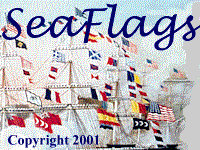
 |
Navy Ceremonial Flags and Guidons |
The national color used by the naval services for parades and ceremonies
has no fringe, although other than in the Marine Corps there is no prohibition
on the use of fringed flags for static display indoors. In the Navy,
the national color is carried on a staff topped with a brass battle-ax
finial
and adorned with a red, white, and blue cord and tassels.
The size normally corresponds to that of the flag with which it is carried--52
by 66 inches in the case of display with the Navy flag, as shown here,
but 61 5/8 by 78 inches with the Navy Infantry Battalion
flag or 48 by 72 inches for the Naval Academy's Brigade
of Midshipmen.
Return to top of page
The United States
Navy flag depicts a modified version of the seal of the Department of the
Navy, an eagle resting upon an anchor with a frigate under sail in the
background. It was approved by President Eisenhower in Executive
Order 10812 on April 24, 1959, to represent the Navy in official ceremonies,
parades, official displays, and similar occasions. The flag measures
52 inches by 66 inches and is surrounded on three sides by golden yellow
fringe 2 1/2 inches wide. The staff is topped by a brass battle-ax
finial, below which are fastened 36-inch-long battle
streamers representing the combat actions carried out by units of the
Navy. Silver and bronze stars embroidered on the streamers indicate
the number of campaigns or battles in each of the wars represented.
In addition, streamers in the colors of the Presidential Unit Citation,
Navy Unit Commendation, and Meritorious Unit Commendation are inscribed
with numerals to indicate the number of such citations awarded to date.
Although widely disregarded by private groups, Navy instructions prohibit
flying this flag on outdoor fixed poles or using it for other than
official Navy purposes.
(SecNavInst 10520.2D)
Return to top of page
The Navy infantry
battalion flag dates back to the late 19th century, when it was adopted
as a battalion color for ships' landing parties ashore. A memorandum
in the collections of the Navy Department Library speculates that it may
have originated in an order by Rear Admiral John Dahlgren in 1864, issuing
"distinguishing pennants for the battalions of the fleet brigade . . .
marked with an anchor." The flag that first appeared officially in
Navy signal books in the late 1800s eventually came to be used to represent
both landing party battalions as well as the Navy as a whole until the
adoption of the Navy flag in 1959. The use of
the infantry battalion flag is now limited to battalions of ship's landing
parties and for battalion organizations of naval shore activities in operations,
ceremonies, and street parades. (SecNavInst 10520.2D)
It is
perhaps most widely seen at training installations and as the battalion
color of construction battalions of the well-known Seabees. The battalion
flag is 61 5/8 inches by 78 inches and mounted on a staff with a battle-ax
finial. Units are authorized to inscribe their designation and
location in white block letters above and below the diamond.
The guidon is
the unit identifying flag for a company, Naval Reserve division, or air
squadron. It is used for parades ashore, at ceremonies, and as prescribed
by the commanding officer. A Navy guidon measures 20 1/8 by 27 3/4
inches and has a 10-inch swallowtail. It is carried on a staff with
a chrome-plated spearhead finial.
At one time, there was also a red version of the same pattern that was
used by artillery and machine gun companies, but it was abandoned after
World War II. There was also a different pattern of guidons carried
by units of the Naval Reserve, but since 1959 all Navy and Naval Reserve
guidons and unit flags have been of the same design.
Return to top of page